Instruction manual
Welcome to MindMapMaker
Welcome to this tutorial of MindMapMaker, a free, fully HTML5 compatible web app to make online mind maps. This is an HTML5 based mind map application. This allows you to create good quality mind maps in the browser. It is also available off-line. You can use the app anywhere. Once the app is in the browser, an internet connection is no longer required, everything happens in your browser on your computer. This app is free and will remain free. There are also no paid upgrades.
So from now on you can map online without installing software on a computer or server. Mind Map Maker is available anytime, anywhere, provided you have an internet connection to start the app.
Mind Map Maker
This is version 3.0 of Mind Map Maker. The first version was made by D. Richard. His version can be found HERE : https://www.mindmaps.app/
The version 2.0 was built by Abdul Azeem. He has further developed this app and has added a lot of functionality to it.
His version can be found HERE : https://app.mindmapmaker.org/#m:new
Version 3.0 is Mindmapping has been further developed on behalf of Brainpartner by Madho Singh of Harsh Technology
Online mind mapping just got easier. The layout has been adjusted. Many unnecessary buttons have been removed. Mind maps can be stored in Mind Map Maker’s free storage server. This way you get a permanent URL for your mind map that can be shared all over the world for mind map sharing. Share your mind map via social media sites. Mind maps stored on the server are read-only and each time you save a new copy a new file with a new URL is created. Google Drive is supported by default and you can now add normal texts, images and videos to your Mindmap branches. You can also indicate relationships between branches.
A very advanced feature that has been added is commenting on the branches. It is still possible to add just one or a few words, but you get free access to an extensive word processor with many options (even adding source codes)
You can link URLs to a mind map and hand-drawn images to individual branches of a mind map to add. A special drawing tool is integrated to draw hand-drawn images on the fly in your mind maps. You can also manually set the line width of individual connection nodes of your mind maps.
Start with an online mind map
Make sure there is an internet connection.
Start the internet browser.

For example, choose: Chrome, Firefox, Safari, Opera, Internet Explorer or Edge.
Start Mind Map Maker
Enter the following in the address bar
app.mindmapmaker.net
and hit Enter
Tip: From now on no internet connection is required. (Until the mind map is saved or shared) The making of the mind map can begin.
Topic
The mind map starts with the topic.
Tip: Later we will see how to place an image in the subject.
The subject is displayed in the center of the screen and is ready to be built up further.
First put the word in the picture that belongs to the subject.
Double-click on the word <Subject>. And type the subject of the mind map.Press the Enterkey.
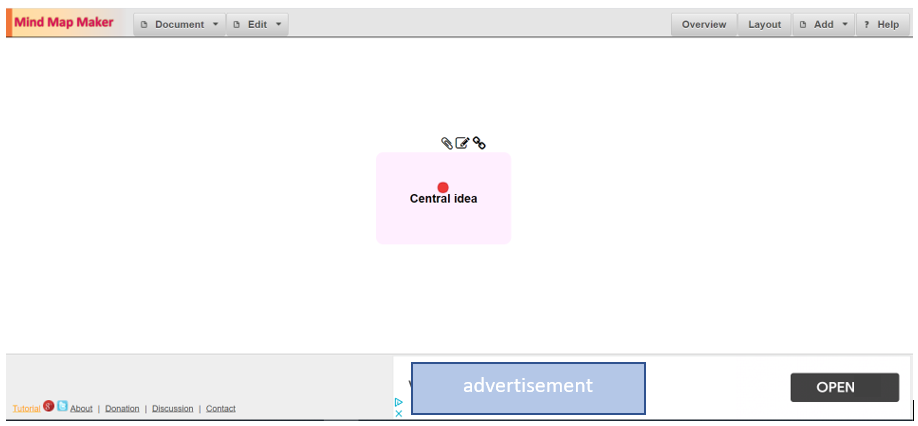
Make main branches with MindMapMaker
When you move the mouse to the center of the subject, a red dot appears in the center.

Click on that RED point and hold down the left mouse button while dragging from that red point to, for example, the top right. You will see a smooth main branch appear.
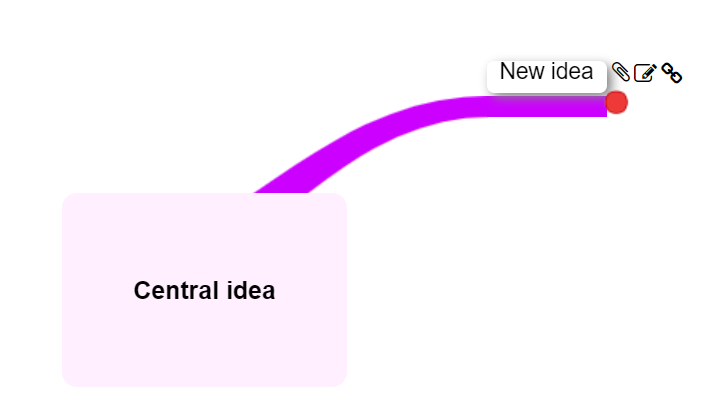
Put words on the branch
If you have created a branch, the word is still selected. You can see that from the blue color. If the word is no longer selected, double-click on it. If your text is blue, you can enter text directly.
After typing in the text, press the Enter key and the text will appear at the end of the branch.
You can change text by double clicking on the text. Then type in the desired new text.
Important :
You select a branch by clicking once on the word on that branch.
You will then see a light frame around the word.
Create sub-branches
In the same way as with a main branch, a sub branch can also be created.

- Move the mouse to the end of a branch. A red dot appears. The mouse automatically turns into a hand when the red dot is pointed.
- Go to the red point and press the left mouse button.
- Hold down the mouse button and drag out a new branch.
Move branches
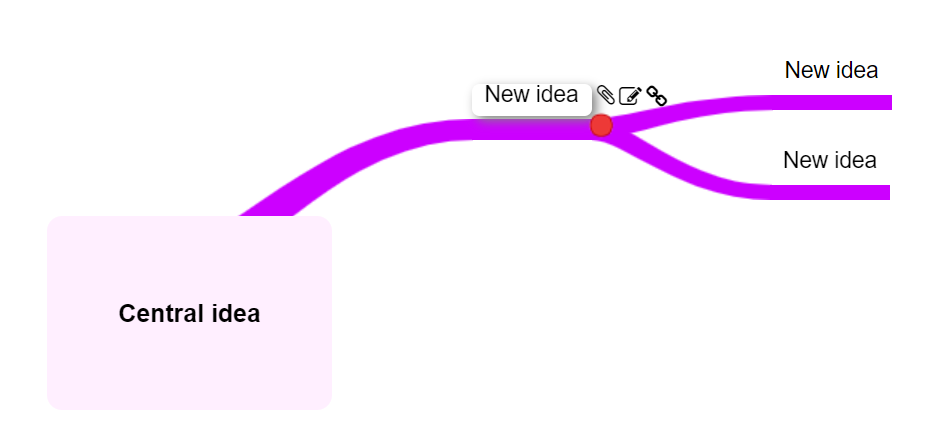
The moment you hold the mouse over a word and then press the left mouse button, you can change the position and the length of the branch.
Add borders
In MindMapMaker you can put words in a border. Click on the relevant word for this.
Then, in the Layout for <Show border>.
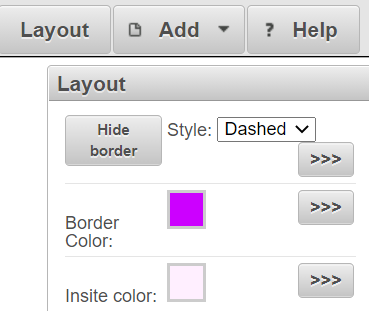
Tip: The button with the three arrows means:
also for all branches afterwards.
Branch color
The color of the branch can be adjusted by selecting the relevant branch and then choosing <Layout> <Branch color>

Edit text
If you want to change the text you use on the branch, click on the relevant word.
Now adjust the size or style.
When adjusting the size of the letters, you can click A + more often, so that the letters get bigger and bigger.

Tip: According to Tony Buzan’s rules, the letters throughout the mind map are all black.
Add images
This version of Mind Map Maker allows you to use images. You can also print and export images as.png.
To add an image to a branch, select that specific branch and click <Adhere> <Image> in the inspector.
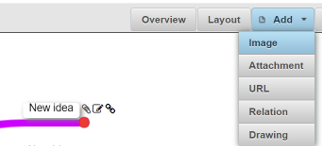
Then the dialog ‘Add / change image’ opens.
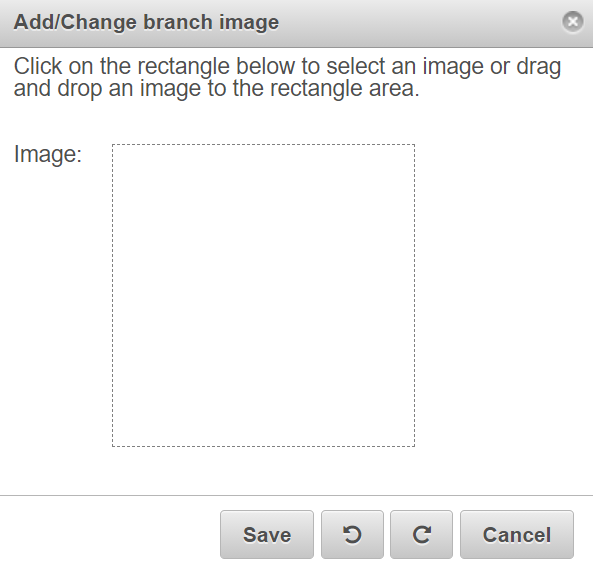
To select an image in MindMapMaker, click the dotted square area, select a file, or drag an image to the dotted square area.
Once an image is selected, it will be loaded and visible within the dotted square
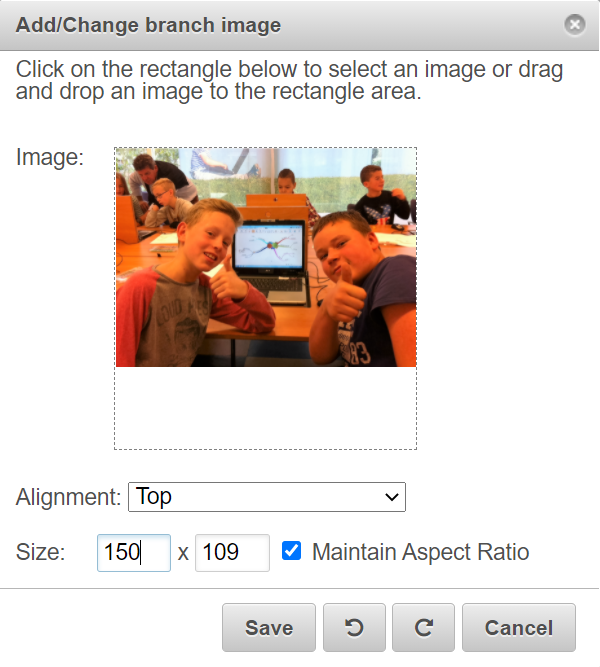
Select the correct alignment for your image and the desired size. Then click on < Save >. Your branch should now have a new image.
TIP: A reasonable size is 150×100.
To remove the image from the branch, select that specific branch and click <Add> <Image> in the menu. Then the dialog box ‘Add / change image’ opens again. Choose: <Remove>

Connect branches – relationships
You can also connect branches with this version of Mind Map Maker.
If you want to connect two branches, first select the branch you want to connect to. Then click < Engaging > < Relationship > in the Info window.

Then click on the second branch to which you want to establish the connection.
After connecting two branches, you will see a dotted line connecting those two nodes.
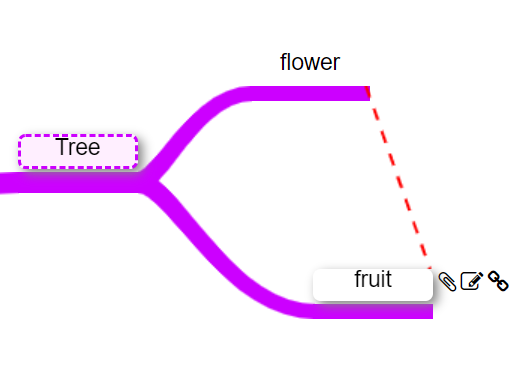
After you create a connection, you will see additional properties for the connection in the inspector.
Changing properties of a connection
After creating a connection, this connection is now selected. To change its properties, check the inspector.
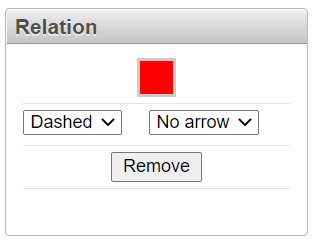
You can change the color (default is red), style (dotted, dash or line) and arrow options. You have the option to show the arrow at both ends or at the end. Select, < single > or < double > from the selection arrow to the right of < No arrow >.
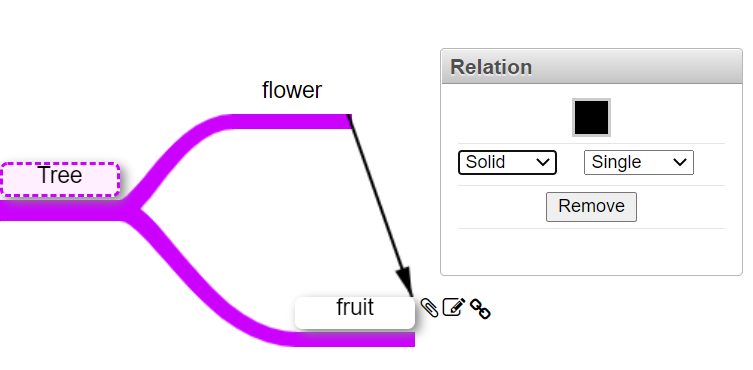
Selecting a connection in MindMapMaker
Select one of the connected branches to select the connection and change its properties. Then click < Engaging > < Relation > and click on the other branch which is part of the connection. Now this connection is selected and you can see its properties in the additional window.
Delete a connection
Select the connection as mentioned above to delete a connection. Now click on the ‘Delete’ button next to the ‘Connect’ button in the inspector.

Add comments to branches
The editor used in MindMapMaker to add comments is one of the best online editors out there. In fact, you might only want to use it as an online tool for additional notes on a branch. It has been decided to use more functions than you might need. As such, this word processor is quite bulky. On the other hand, you probably won’t miss anything. Of course it is always possible to add just a few words or a short sentence.
Basic features
The top row of buttons are almost all self- explanatory , except < Source code>. You will not need these, but in principle it is possible to place HTML codes. For example, moving animations can be included in the comment. Youtube videos can also be embedded via the Source code.



The middle and bottom rows contain standard buttons that you will always find on a simple word processor. Most buttons are also self-explanatory. If necessary, hold the mouse over a button for additional explanation of that button.
Note that there is no save button or save button optional. Mind Map Maker automatically saves your work when you close the editor.
DO NOT press the Maximize Screen button. This leads to unexpected errors.
Deleting a comment is possible by deleting all content.
Hyperlinks
In MindMapMaker it is possible to create hyperlinks within this comment; web links to other web pages. Please note that these are then included in the comment and not directly attached to the relevant branch.
All of the buttons above can be useful and have some nice functions. With the last button (Omega character) you can insert many special characters in the document.
Embed Videos
Videos or other rich content from other websites using the < Source Code > button . You can embed youtube videos in your document. It supports content from sites such as YouTube, Flickr, Qik, Vimeo, Hulu, Viddler, MyOpera, etc. Paste the content url and change it as desired. For example, if you want to embed a youtube video, paste the youtube URL in the format:
<iframe width = “640” height = “360” src = “https://www.youtube.com/embed/eO6jqTQzMAI” frameborder = “0” allow = “autoplay; encrypted-media” allowfullscreen> </iframe>
Add images into the attachment
If you want, you can place images into the attachment.
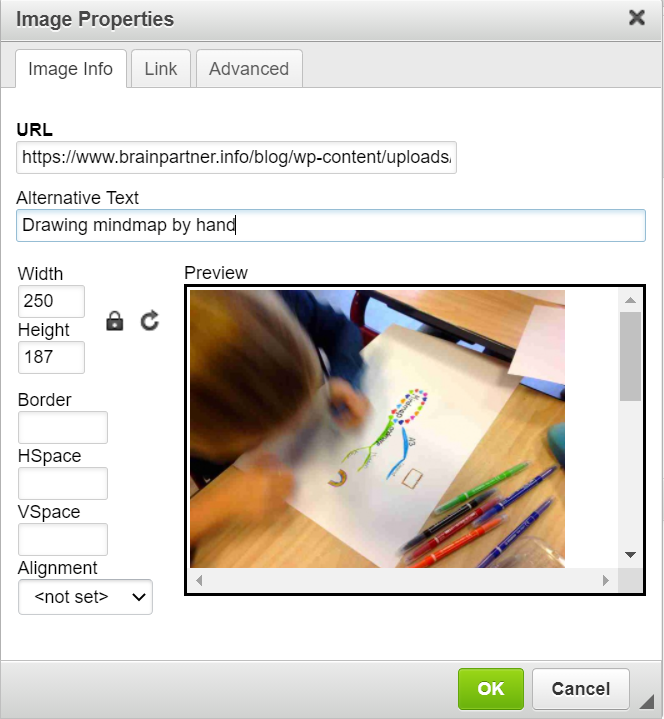
Enter the URL of the image you want to use. You can also add a caption to this image by selecting the ‘<Alternative Text>’ option. It is used when a browser cannot display the image. A handy feature of this tool is that you can resize the image or change its position afterwards.
A common way to get the URL of an image from a website is to right-click the image and click < Copy link address >.
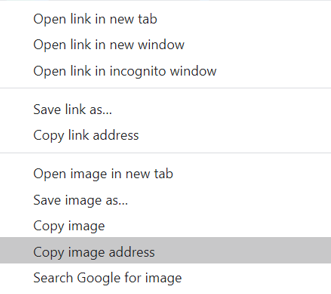
Warning: The online image you are using may be copyrighted by its owner. Use it wisely.
Note: If you use a URL to insert an image in your comment, it will not be saved as part of the mind map document. The image is still external and as long as the URL is valid, the image will be displayed.
Tip: Use images with a small file size. This will make the whole mind map file smaller, especially if you have a large mind map with many images. For example, .bmp files are relatively larger than .jpg or .png files. You can use image resizers (for example THESE ) to reduce the size.
Create manual drawings on a branch
{Only works on touch screens}
You can associate handmade drawings with individual branches. To link a drawing to a branch, click on that specific branch and click the <Add> <Draw> button in the top right corner of the screen.
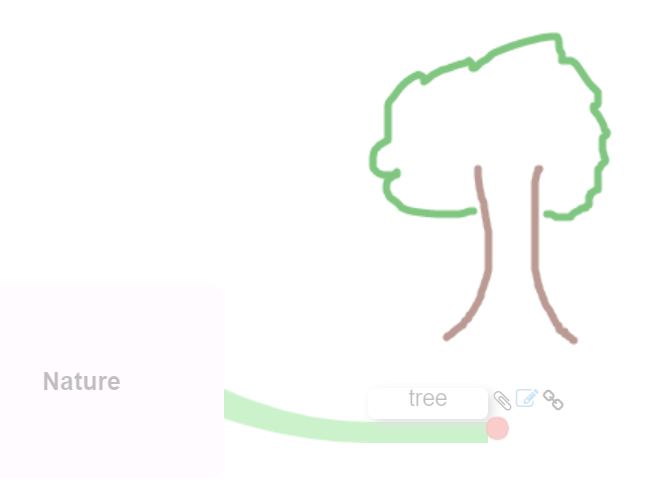
The drawing window opens.
Use the pencil tool to draw on the window

Use the eraser tool to erase part of your drawing.
Click the delete icon to erase the entire image.
Use the color picker to change the color of the pencil.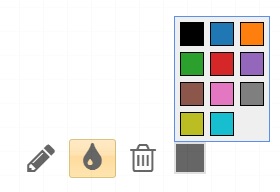
Note: The drawing belongs to the branch that is currently selected.
With the movement keys (arrows on keyboard), you can select other branches.

To return to the Mind Map screen,
click on <And> <Draw > again.
Once an image is added to a branch, the color of the pencil icon associated with the branch changes.
To remove the drawing attachment from a branch, click that branch. Go to the drawing screen. Use the eraser button to erase the entire image. This will delete the attachment. Click the <Next> <Draw> button again to return to the mind map screen. You can now see the color of the pencil icon associated with that branch go back to black.

Using Google Drive with Mind Map Maker
Google Drive is a file storage and sync service from Google that enables users to use cloud storage, file sharing and collaborative editing. Collaboration support allows multiple users to work with your document in real time at the same time. Real-time collaboration is currently not possible with Mind Map Maker. However, saving and opening the file is excellent. Step by step information is given below on how to use Google Drive. A Google account is required to access Google Drive. If you use Google products like Gmail and Plus, you probably have one or it can be made for free.
The Google Drive support page provides more information about Google Drive.
Requirements
As mentioned earlier, you need a Google account to access Google Drive. If you use Google products like Gmail, Google Plus, or Blogger, you probably have one. If you don’t have one, you can create one for free at www.google.com/accounts
Most likely you have a personal (private) Google account and can access Google Drive directly. If you’re using a Google Apps corporate account, the administrator must enable Google Drive access (it should probably already be enabled). Go to http://drive.google.com to check if you can access Google Drive. That is, you can sign up and use Google Drive properly.
While saving and opening files from Google Drive, data is transferred directly from your browser to Google Drive. It is not transferred through our servers. As such Mind Map Maker has no access to your google account and is not known at all. To check if you can access Google Drive, it’s best to go to http://drive.google.com and view your own data.
To start.
When you use Google Drive with Mind Map Maker for the first time, you must give permission to let Mind Map Maker use your Google Drive account. When opening or saving mind maps in Google Drive, data is transferred directly from your browser to a Google account. Authentication is a way of letting Google know that you trust Mind Map Maker and that Mind Map Maker is allowed to use your Google account to save and open files. To allow Mind Map Maker to use your Google account, click on < Authorize >.

As with all Google products, if you are not signed in to your Google account, the page will redirect you to the login page. Sign in with your Google account that you want to use for saving mind maps. After you sign up, Google will ask for your permission to use Google Drive with Mind Map Maker. Check the image below. Click on < Accept > to continue.
Once accepted, Mind Map Maker can save and retrieve files from Google Drive. If you visit http://drive.google.com at this point, you will notice that a new app, Mindmaps, has been added to your Google Drive account. This is for your convenience so that you can open Mind Map Maker directly from Google Drive by clicking on it.
If you first saved or opened the file, this operation will now continue. Mind Map Maker does not keep asking you to verify unless you are signed out of your Google account. Remember that MindMapMaker cannot open your mind maps stored in Google Drive if you are not logged in. If you try to access mind maps without logging in, Mind Map Maker will ask you again to log in to your Google account.
Mind maps stored in Google Drive are private. Therefore, you can only open or save an existing map with a Google account if you previously created that map with the same Google account. For example, you have created a mind map called ‘Vacation’ with google id, ‘abc@gmail.com’; You cannot access this map if you are logged in to another account, for example ‘xyz@gmail.com’. This way, mind maps are private and only the creator can view them. (You can share your Google Drive maps with your friends. This is listed below.)
Saving Mind Maps with Google Drive
To save mind maps in your Google Drive account, click on < File > < Save As … > And choose < Google Drive >.
Note: When you save a mind map on our own server as a public mind map, it will remain public and you can share the URL with your friends. Later, if you edit and save this mind map as a public mind map, you will get a different URL. That is, the mind map is saved as another mind map. This is different in Google Drive. There is only one version and one URL. Even if you make changes and save the mind map, the same mind map will be overwritten with the same URL.
Public mind maps have different URLs every time you change and save them. Private (Google Drive) mind maps have only one URL. It will overwrite the initial mind map if you change and save it.
Accessing Mind Maps Stored on Drive
To view all mind maps you have stored with your current Google account, click <File> <Open> <Open with Google Drive> <Open> This will open a window with any mind maps you have saved with the current Google account. You can also use the search box to search for a file.

You can also open files by going to http://drive.google.com. There you will see the files stored in your Google Drive account. Click on a .json file. Mobile browsers do not show this feature and the only option is to use <File> <Open> <Open with Google drive> <Open> .
[Next doesn’t work yet; app still needs to be signed in to Google Play] If clicking .json files does not open Mind Map Maker app, MindMapMaker may not be selected as the default application for .json files (extension .json). In this case, another configuration step is required. Right-click a .json file, click <Open With>, then select <Manage Apps>. Find Mind Map Maker in the apps list and check the <Use by default> box. From now on, clicking your Mind Map Maker files from Google Drive can open automatically with Mind Map Maker app.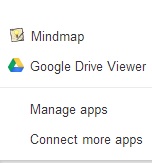
In case Mind Map Maker is not listed in the apps menu, click on “Connect more apps” and look for Mind Map in the window that opens. In this way Mind Map Maker is manually added to your Google Drive.
Sharing your Google Drive mind map with friends
As mentioned earlier, mind maps stored in Google Drive are private. If you want, you can share your Google Drive mind maps with your contacts. You can choose which friends can access and access your files. You can read Google ‘s support page about sharing for more information.
You can share a MindMapMaker document with another Google Drive user. See the image below.


Clicking the Share icon opens a new window where you can add / select individual friends or a group of friends to share the document. You can also invite them via their email.
When you share a document to Google Drive, Google sends a link to the recipient. They can click this link to open the file. Their Google Drive account will automatically show this file. In Mind Map Maker, the recipient can open the shared file from <File> <Open> [Open with Google Drive] <Open>
A function of sharing files via Google Drive is that you can set the access rights. With the <Can edit> access right, the original file will be rewritten when the file is saved after some modification. So more than one user can collaborate with the same file and see each other’s changes. If the access privilege is <May view>your friend does not have the option to rewrite the original file. However, they will be given an option to save the file in their Google Drive account under a different name.

Here you can also get a public link. The difference with saving via our servers is that you remain fully owner of your mind map and it is therefore not stored on our servers.
A publicly shared link from Google Drive has this form:
A publicly shared folder stored on our server has this form:
After you share the same mind map with your friends, your friends can open the mind map by pasting the URL into their browser.
One limitation of Google Drive file sharing is that even if you make your mind maps completely public, the end user will still need a Google ID to read the file. People who are not logged in to a Google account will still not be able to read your file without logging in first and then authorizing Mind Map Maker. For this limitation, we recommend that you work with your own mind map and don’t save it to Google Drive until it’s ready to be shared as public. Once your mind map is ready and final, make it public using public storage on our server. Thus, public can view your mind map without the requirement of a Google account Share the URL with your friends. If you find that URL is a bit too long, you can use a short URL in the Share window.
Sometimes when you open a Google Drive mind map, MindMapMaker will tell you that you cannot view this mind map because you don’t have enough permissions to view the mind map. This is because the mind map you are trying to open was not created by the currently logged in Google ID or the mind map was not shared with the currently logged in Google ID. In this case, go to drive.google.com, sign out and sign in with the correct Google ID. This often happens if you use multiple Google Accounts for different purposes or if your browser is shared by different users.

Sometimes when you open a Google Drive mind map, MindMapMaker will tell you that you cannot view this mind map because you don’t have enough permissions to view the mind map. This is because the mind map you are trying to open was not created by the currently logged in Google ID or the mind map was not shared with the currently logged in Google ID. In this case, go to drive.google.com, sign out and sign in with the correct Google ID. This often happens if you use multiple Google Accounts for different purposes or if your browser is shared by different users.
Special features of Mind Map Maker
Exporting
mind maps as image Mind Map Maker allows you to export created mind maps as images. (.png) This is useful, for example to integrate your created mind map into other applications and software.
To export your mind map as an image, select
<File> <Export to .png>

From the displayed dialog box, your created mind map will be displayed as an image. Right-click on the image to download the mind map and select <Save Image As …>.

Once you click on <Save Image As … ‘>, you will be prompted for a location where you want to save your image. So after you save your mind map as easily view image from the saved location.
Printing
You can also print your mind map with MindMapMaker.
Choose <File> <Print> from the menu to print your mind map. It has a printer image next to it.
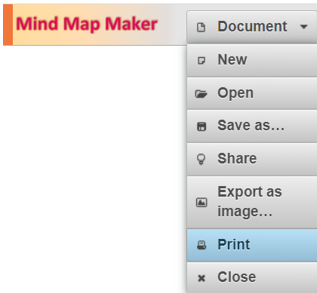
Once you select the < Print > option , it will show you the default browser print options. You can choose the printer if you have more than one printer. The Chrome web browser also allows you to save it as an Adobe PDF file. To do this, select [ Destination ] <Change>
By integrating printing functions directly into the app, you save time.
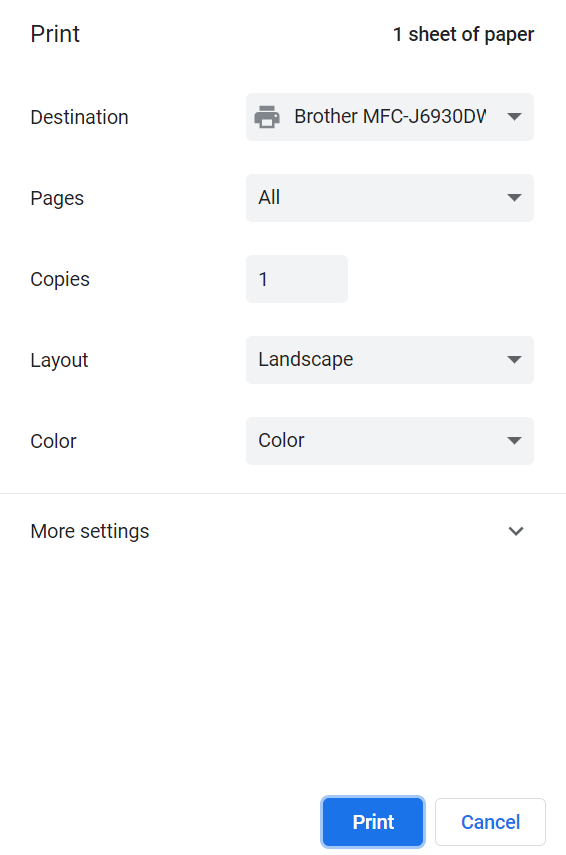
Specifications of the Mind Map Maker Webapp
About MindMapMaker
This is an HTML5 based mind mapping application. This allows you to create good quality mind maps in your browser.
MndMapMaker is available offline. So there is no constant need for an internet connection. Everything happens in your browser on your computer.
Why Mind Map Maker
There are many mind mapping apps. However, these apps are often very limited or too extensive. Most web apps ask for premium features that have to be paid for.
Mind Map Maker is free and will remain free !
To keep the app free, there are occasional ads. You don’t have to click on it. Only do that if you are interested.
You can also use an Ad Blocker. We even recommend this for schools. In that case we would really appreciate a voluntary donation .
Requirements
You need a solid web browser that has all HTML5 functionality and supports CSS3.
Chrome 10+, Firefox 3.6+, Safari 5+, Opera 10.6+, IE9 + should be able to do this.